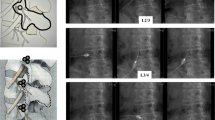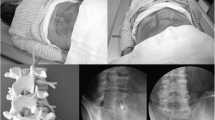Abstract
Background
It has been reported that rat L5/6 lumbar discs are innervated mainly by L2 dorsal root ganglion neurons. We previously reported that L2 spinal nerve infiltration was effective for discogenic low back pain (DLBP) patients, although the diagnosis was based only on the results of physical examination, plain films, and magnetic resonance imaging (MRI). The purpose of the current study was to evaluate L2 spinal nerve block for DLBP patients retrospectively based on MRI findings and surgical results.
Methods
A total of 62 patients with only LBP and no accompanying radicular pain were investigated. Patients had only one level of disc degeneration on MRI. When pain was provoked during discography, we performed surgery at the next stage (40 patients). In all, 22 patients were excluded owing to negative discography results. Of the 40 patients, we evaluated 25 strictly selected patients suffering from DLBP. DLBP was diagnosed when the patient experienced pain relief at least 2 years after anterior lumbar interbody fusion. Fifteen patients who did not show pain relief after surgery were used for the non-DLBP group. L2 spinal nerve infiltration using 1.5 ml of lidocaine was performed in all 40 patients before surgery. The visual analogue scale (VAS) score after L2 spinal nerve infiltration was recorded, and an association of L2 spinal nerve infiltration and DLBP was explored.
Results
Low back pain scores assessed using the VAS score, the Japanese Orthopedic Association score, and the Oswestry Disability Index score in the two groups were not significantly different. L 2 spinal nerve infiltration was effective for 27 patients but not effective for 13 patients; the VAS score after 15 min and 2 h improved in the DLBP group compared with that of the non-DLBP group (P < 0. 05). L2 spinal nerve infiltration was more effective in DLBP patients (21 patients, 84%) than in the non-DLBP group (6 patients, 40%) (P < 0.05).
Conclusions
In the current study, L2 spinal nerve infiltration was effective in 84% of selected DLBP patients and is thought to be a useful tool for diagnosing DLBP. However, we should take into consideration that the L2 spinal nerve infiltration was effective in 40% of non-DLBP patients as well.
Similar content being viewed by others
References
Bogduk N, Tynan W, Wilson AS. The nerve supply to the human lumbar intervertebral discs. J Anat 1981;132:39–56.
Ohtori S, Takahashi Y, Takahashi K, Yamagata M, Chiba T, Tanaka K, et al. Sensory innervation of the dorsal portion of the lumbar intervertebral disc in rats. Spine 1999;24:2295–2299.
Ohtori S, Takahashi K, Chiba T, Yamagata M, Sameda H, Moriya H. Sensory innervation of the dorsal portion of the lumbar intervertebral discs in rats. Spine 2001;26:946–950.
Nakamura S, Takahashi K, Takahashi Y, Yamagata M, Moriya H. The afferent pathways of discogenic low back pain. J Bone Joint Surg Br 1996;78:606–612.
Mendez R, Bailey S, Paine G, Mazzilli M, Stedje-Larsen E, Nance B, et al. Evaluation of the L2 spinal nerve root infiltration as a diagnostic tool for discogenic low back pain. Pain Physician 2005;8:55–59.
Buenaventura RM, Shah RV, Patel V, Benyamin R, Singh V. Systematic review of discography as a diagnostic test for spinal pain: an update. Pain Physician 2007;10:147–164.
Carragee EJ, Lincoln T, Parmar VS, Alamin T. A gold standard evaluation of the “discogenic pain” diagnosis as determined by provocative discography. Spine 2006;31:2115–2123.
Macnab I. Spondylogenic backache: soft tissue regions. In: Backache. Philadelphia: Williams & Wilkins, 1990. p. 120–147.
Thompson JP, Pearce RH, Schechter MT, Adams ME, Tsang IK, Bishop PB. Preliminary evaluation of a scheme for grading the gross morphology of the human intervertebral disc. Spine 1990;15:411–415.
Pauza KJ, Howell S, Dreyfuss P, Peloza JH, Dawson K, Bogduk N. A randomized, placebo-controlled trial of intradiscal electrothermal therapy for the treatment of discogenic low back pain. Spine J 2004;4:27–35.
Shuff C, An HS. Artificial disc replacement: the new solution for discogenic low back pain? Am J Orthop 2005;34:8–12.
Ploumis A, Pinto MR, Schellhas KP. Disc space injection with Marcaine as a method to evaluate painful nonunion of an interbody fusion device: a case report. Spine J 2007;7:74–78.
Ohtori S, Kinoshita T, Yamashita M, Inoue G, Yamauchi K, Koshi T, et al. Results of surgery for discogenic low back pain: a randomized study using discography vs. discoblock for diagnosis. Spine 2009;34:1345–1348.
Chen J, Hou S, Peng B, Wu W, Shi Y, Li L, et al. Effect of the L2 ramus communicans on the nociceptive pathway in lumbar intervertebral discs in rats. Eur J Pain 2008;12:798–803.
Zhang Y, Kerns JM, Anderson DG, Lee YS, Chen EY, Tannoury C, et al. Sensory neurons and fibers from multiple spinal cord levels innervate the rabbit lumbar disc. Am J Phys Med Rehabil 2006;85:865–871.
Brena SF, Wolf SL, Chapman SL, Hammonds WD. Chronic back pain: electromyographic, motion and behavioral assessments following sympathetic blocks and placebos. Pain 1980;8:1–10.
El Mahdi MA, Latif FYA, Janko M. The spinal nerve root “innervation” and a new concept of the clinicopathological inter-relation in back pain and sciatica. Neurochirurgia 1981;24:137–141.
Murata Y, Kato Y, Miyamoto K, Takahashi K. Clinical study of low back pain and radicular pain pathways by using l2 spinal nerve root infiltration: a randomized, controlled, clinical trial. Spine 2009;34:2008–2013.
Ohtori S, Takahashi K, Chiba T, Yamagata M, Sameda H, Moriya H. Phenotypic inflammation switch in rats shown by calcitonin gene-related peptide immunoreactive dorsal root ganglion neurons innervating the lumbar facet joints. Spine 2001;26:1009–1013.
Ohtori S, Takahashi K, Chiba T, Yamagata M, Sameda H, Moriya H. Calcitonin gene-related peptide immunoreactive neurons with dichotomizing axons projecting to the lumbar muscle and knee in rats. Eur Spine J. 2003;12:576–580.
Ohtori S, Inoue G, Koshi T, Ito T, Yamashita M, Yamauchi K, et al. Characteristics of sensory dorsal root ganglia neurons innervating the lumbar vertebral body in rats. J Pain 2007;8:483–488.
Author information
Authors and Affiliations
About this article
Cite this article
Ohtori, S., Nakamura, S., Koshi, T. et al. Effectiveness of L2 spinal nerve infiltration for selective discogenic low back pain patients. J Orthop Sci 15, 731–736 (2010). https://doi.org/10.1007/s00776-010-1538-1
Received:
Accepted:
Published:
Issue Date:
DOI: https://doi.org/10.1007/s00776-010-1538-1




